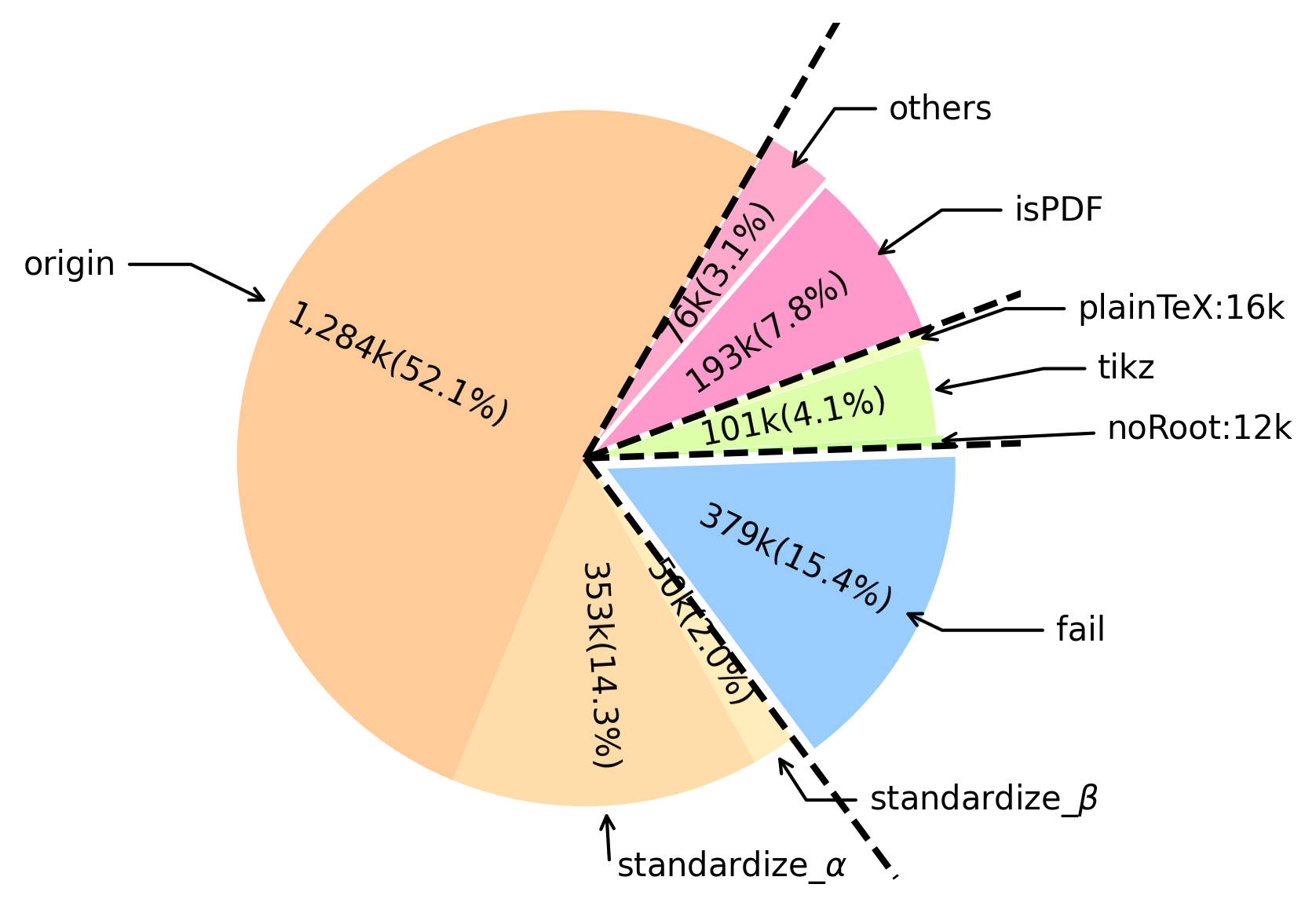File size: 4,022 Bytes
3b60a60 44e8635 37e2801 1cac379 4286eed 3b60a60 5e8ad48 3b60a60 1aadfea 3b60a60 |
1 2 3 4 5 6 7 8 9 10 11 12 13 14 15 16 17 18 19 20 21 22 23 24 25 26 27 28 29 30 31 32 33 34 35 36 37 38 39 40 41 42 43 44 45 46 47 48 49 50 51 52 53 54 55 56 57 58 59 60 61 62 63 64 65 66 67 68 69 70 71 72 73 74 75 |
---
license: mit
task_categories:
- question-answering
- text2text-generation
- text-generation
language:
- en
pretty_name: uparxive
size_categories:
- 1M<n<10M
configs:
- config_name: example_data
data_files: "example.json"
# - config_name: full_data
# data_files: "release.uparxive.json.tar.gz"
# viewer: false
---
# The **Uparxive** Dataset
The [uparxive](https://github.com/veya2ztn/uparxive) aims to provide a llm-friendly dataest for the whole arxiv .tex source. A similiar dataset is the [unarxive](https://github.com/IllDepence/unarXive), while the uparxvie use a different tool chain.
The Uparxive dataset is stored in `.json` format, which can be seamlessly converted into Markdown `.md` format.
See github [repo](https://github.com/veya2ztn/uparxive) for a simple converter.
### Format Rules
The Uparxive dataset adheres to the following rules:
- **Tables and Figures**: Elements enclosed within `\begin{table} \end{table}` and `\begin{figure} \end{figure}` tags are extracted and appended at the end of the document for clarity and organization.
- **Citations and References**: Citations (`\cite{}`) and references (`\ref{}`) are converted to more explicit forms to improve readability. Examples include:
- Direct mentions: `(See [Ref. [1,2] of ArXiv.1512.03385])`
- Contextual references: `in [Ref. [1,2] of ArXiv.1512.03385]`
- Equation/Section/Figures/Tables references: `in [Equation [1] of ArXiv.1512.03385]`, depending on the usage context.
- **Mathematical Notations**:
- **In-line Math**: Single dollar signs `$` are used for in-line mathematical expressions, e.g., `$\alpha$`.
- **Block Math**: Double dollar signs `$$` denote block mathematical expressions, e.g., `$$\mathbf{y}=\mathcal{F}(\mathbf{x},\{W_{i}\})+\mathbf{x}.$$`
> See [1512.03385.json](https://github.com/veya2ztn/uparxive/blob/release/example/1512/1512.03385/uparxive/1512.03385.json) and [1512.03385.md](https://github.com/veya2ztn/uparxive/blob/release/example/1512/1512.03385/uparxive/1512.03385.md) as example
### Dataset Sources [optional]
<!-- Provide the basic links for the dataset. -->
- **Repository:** [More Information Needed]
- **Paper [optional]:** [More Information Needed]
- **Demo [optional]:** [More Information Needed]
#### Data Collection and Processing
To construct the complete Uparxive dataset from scratch, please refer to the GitHub [repo](https://github.com/veya2ztn/uparxive).
> Note: The "full" version of uparxive was generated from all of *arXiv.org* including non-permissively licensed papers. Make sure that your use of the data is compliant with the paper's licensing terms. (For information on papers' licenses use [arXiv's bulk metadata access](https://info.arxiv.org/help/bulk_data/index.html)).
> Note: paper under [CC BY-NC-ND](http://creativecommons.org/licenses/by-nc-nd/4.0) license are not included in the dataset.
[More Information Needed]
#### Who are the source data producers?
- **arXiv Bulk Data Access**: Access and download bulk data directly from arXiv using the AWS S3 `request-payer` dataset. Detailed instructions and access points can be found here: [arXiv Bulk Data Access](https://info.arxiv.org/help/bulk_data.html).
- **arXiv API**: For more specific data needs or metadata, use the arXiv API. Documentation and usage guidelines are available here: [arXiv API](https://info.arxiv.org/help/api/index.html).
- **Important Note**: When crawling arXiv source files, ensure to use `export.arxiv.org` instead of the official `arxiv.org` domain to avoid overloading the main site.
[More Information Needed]
# Statistic
This dataset part will need 156G dick space for 1.7M papers.
Up to April 2024, there are around 2,450,893 papers in the arxiv source, and the uparxive dataset has covered 1,700,000 papers. Those missing parts are mainly due to the lack of the `.tex` source or the failure of the conversion process.

|